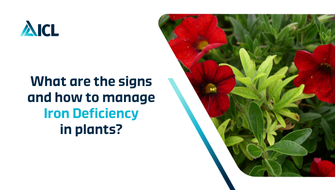Zinc deficiency occurs when plants lack an adequate supply of this essential micronutrient (Zn). Often, when a crop is deficient in one trace element, it may be lacking several or even all micronutrients.
Zinc deficiency occurs in young leaves so can be found in new spring growth. Now is a good time to inspect overwintered crops for signs of nutrient deficiency – to rectify any issues before the important spring sales season.

Zinc Deficiency in Poinsettia
What are the symptoms of Zinc Deficiency?
Zinc plays a crucial role in plant growth, influencing various biochemical and physiological processes. Deficient plants are more vulnerable to diseases and pests, leading to reduced health and productivity. Common symptoms include:
- Interveinal chlorosis – Yellowing or whitening of tissue between leaf veins while the veins remain green, especially in younger leaves.
- Stunted growth – Shorter stems, smaller leaves – overall reduction in plant size.
- Leaf distortion – Misshapen leaves with irregular margins or puckering.
- Delayed flowering and fruiting – Slower development, reduced yields, and compromised quality.
- Weaker root systems – Poor root growth, limiting nutrient and water uptake.

Zinc Deficiency in Pelargonium
How should you manage Zinc Deficiency?
Prevent Zinc deficiency with Micromax Premium. This high-performance granular fertiliser provides all essential trace elements, including zinc, in a single application. Designed for maximum efficiency, it:
- Supports healthy plant growth for up to 16 months.
- Works effectively even in growing media with a pH above 6.5.
- It is easy and safe to use.
Micromax Premium is a key ingredient in our Levington Advance bagged range and Levington Advance bespoke mixes.
Correct Zinc Deficiency with Peters Professional Foliar Feed (27-15-12+TE). For a fast-acting solution, this premium water-soluble fertilizer delivers zinc directly to the leaves. Thanks to the unique M-77 chelating complex, trace elements remain available for quick absorption and lasting effectiveness.

Zinc Deficiency in Poinsettia
Did you know?
- Organic matter in soil improves zinc availability by enhancing microbial activity and soil structure.
- Soil pH affects zinc uptake – optimal availability is typically between pH 6 and 7.
0 Brands found
2 Products found
13 Resources found



Our knowledge
Tips & tricks, disease prevention, crop and market related information
Explore our knowledge












